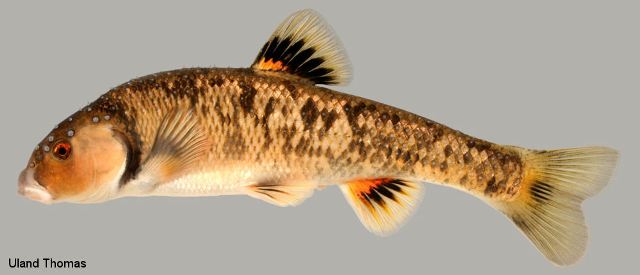Central Stoneroller
(Campostoma anomalum)

The common name "central stoneroller" comes from the behavior of the male excavating a nest by moving gravel with its nose. The photo to the left is of a large breeding male.
Description
Stonerollers are moderately stout brownish colored minnows with small eyes and short, rounded fins. The snout is bluntly rounded and projects beyond the nearly horizontal mouth. Their mouth is always white in color. Young and non-breeding adults usually have dark blotches over much of their body. Large breeding males have some orange and black on fins, large pointed tubercles (horn like bumps) on their head, and reddish orange eyes.
Habitat and Habits
The stoneroller is found throughout Ohio in moderate to high gradient streams with sandy to gravely substrate. They prefer riffle areas where riffles and pools alternate in rapid succession. However, they are very tolerant and can survive in almost any stream with a food supply. They are one of the most common species of fish in the state.
Reproduction and Care of the Young
Stonerollers spawn between March and late-May. Males dig spawning pits just upstream or downstream of riffles and aggressively defend their chosen site from other males. Females remain in deeper water near the spawning pits and enter the pits individually or in groups to deposit eggs. The adhesive eggs become lodged in the gravel and are abandoned prior to hatching. Most stonerollers become sexually mature in their second or third summer.